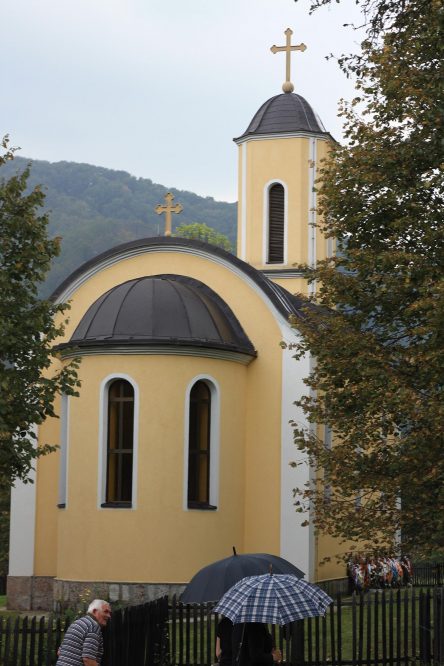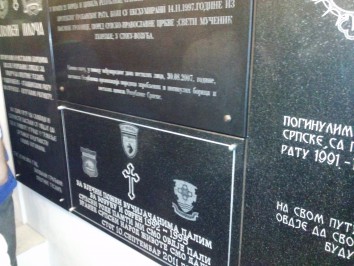Stog is a small village in the vicinity of Vozuća, a local community in the municipality of Zavidovići[1]. It is located in the tame valley of the Krivaja River, surrounded by hills and mountains, a landscape of exquisite beauty, rich in pasture land, forests and orchards. In 1992, the beauty of nature was irrelevant. Vozuća became “strategically” significant and what followed resulted in thousands of casualties, disabled war-veterans and displaced persons. April 1992 saw the exodus of Bosniaks from Vozuća, September 1995 saw the exodus of Serbs. What happened in the meantime makes Vozuća perhaps the bloodiest war zone in Bosnia and Herzegovina, marked by heavy fighting, war crimes and missing persons.

Vozuća is a place emblematic of the strife of the Serb people in the past war, and every year on 10 September in Stog, a commemoration is held to honour the dead and missing, and to mourn the loss of homesteads after centuries of habitation in the area. The official title of this event is “Commemoration of the anniversary of the exodus of the people of Vozuća, from settlements along the Krivaja River valley and southern Mount Ozren” and it is organised by the Zavidovići Homeland Association, Doboj[2]. With the help of a friend from the Doboj branch of BORS[3] and with his recommendation, we visited this association on two occasions, presented our work with war-veterans and joint visits of commemorations that mark important dates from the past. We soon received an official invitation from the association welcoming our group. The commemoration programme planned for a gathering of the participants in the settlement of Tumare, some 22km from Stog, where the traditional “Exodus March” would begin. The march would retrace the route taken by refugee columns in 1995. The arrival of participants at the destination in Stog would mark the beginning of the commemoration, so we decided to joint them at that point.
Most of the group made up of war-veterans from Serbia, Croatia, both Bosnian-Herzegovinian entities and us from CNA arrived in Zavidovići the night before, while others joined the group in the morning. We were also joined by members of the disabled war-veterans association from Zavidovići.
The Council of Disabled War-Veterans of the Army of the Republic of BiH in the Municipality of Zavidovići[4], that had been our host at the commemoration of the battle at Site 715 the year before, invited us to attend another event to be held that same day in Vozuća. It concerned the same event, but from a different perspective. That day is marked on the Bosniak side as the “Day of Liberation of Vozuća”. It was very important for us to see how the same event is experienced and interpreted on both sides and to hear, on one and the same day, two opposing narratives. We also wanted to feel the atmosphere among those present when they are joined by “former enemies” at their ceremony. However, because the two events were taking place at the same time, we were unable to accept the invitation this time. We spent the morning with members of this association, who had invited us to visit the Memorial Room, Park “Kamene kugle”, “Memorial to the victims of the 1992-1995 war” and their workshop where they produce and repair prosthetics for disabled war-veterans. The visit to the workshop evoked great interest among the veterans from our group and our hosts did their best to present their work and products. If it were not for the time constraints, our visit to the workshop would have been much longer.
Leaving Zavidovići, we formed a column and set off for Stog, some 25km away. Fourteen kilometres down the road, we entered the former war zone still bearing visible traces of destruction and ruins of buildings. This is also where predominantly Serb settlements were once located. There are some reconstructed houses, especially holiday homes, but the number of returnees is small and mainly consists of older people.
At the entrance to Stog, we were met by members of the Federal Ministry of Interior, many of them distributed along the road, a sign that this event had been characterised as potentially presenting a high risk for the security of the participants. A police officer directed us to where we could park our cars, and we then went towards the Church of St George where a large tent had been put up in the courtyard with rows of tables and chairs and an outdoor kitchen. Judging by the façade, it seemed the church had been reconstructed. There was a memorial with a cross in the courtyard. A few hundred people were already in front of the church and in the tent. Serb “patriotic” songs thundered from the sound system.
We signed in with the lady in charge of protocol and she told us to go into the tent and explained that we would be called to lay our wreath. Our formal host had participated in the march, so we were somewhat lost in the crowds. People did not know us, so they looked at us strangely and asked about who we were and what we were doing there.
And then the sky opened up. Torrents of rain, thunder and lightning. Everyone ran under the tent and started crowding in to avoid the pouring rain. At that moment, the first bars of “March on the Drina” started coming from the loudspeakers and the front of the column bearing the Serbian tricolours came into view. The people beneath the tent stood up and applauded the arriving participants in the march. The column was seemingly endless, hundreds of people, mostly young people. The first thing that occurred to me was to wonder how many of them had lost their fathers at this battle site. The march participants came into the tent, tired and soaked, to change their clothes. We got wind that the Holy Liturgy and Mass for the fallen at the Vozuća front was under way, and some of our group went to the church. On the walls I noticed memorialplaques bearing the names of fallen fighters of the Republika Srpska Army from Vozuća and the municipalities of Bijeljina, Srbac, Prnjavor, Vukosavlje, Modriča, Teslić and Doboj. The reason why the plaques are inside the church is the same as the reason why this gathering is being protected by a large police force.

The ceremony of laying wreaths at the Memorial to the killed and missing members of VRS in the courtyard followed the church service. The rain was so heavy that it drowned out the announcements from the loudspeakers so that the hostess used gestures to indicate whose turn it was to lay the wreath. Four veterans from our group laid the wreath and honoured the victims. Soaked through, they joined us back under the tent. We met with the host, also exhausted and soaked from the rain, only briefly when he greeted and welcomed us. The circumstances did not allow for a meeting between members of his associations and the veterans from our group. The speech of the organiser addressing participants and guests had to be cancelled, so we decided to get out of the rain and wind and forgo the remainder of the commemoration. We said our goodbyes and headed back towards Zavidovići.
Our everyday lives are marked by celebrating “glorious military victories” that for some are an “exodus” and a time for mourning. In both cases, there are people who are no longer with us and whose deaths are a tragedy for their families and communities. By remembering these people, we also remember the horrors of war. And in remembering we can wish for our, and the children of “the others”, a better future, for if we do not start from three, we will be mired deep in our problems.
[1] Zavidovići – Town and Municipality in the Federation of BiH
[2] Doboj – Town and Municipality in Republika Srpska
[3] BORS – Veterans Organisation of Republika Srpska
[4] Official title of the disabled war-veterans associaiton